This post may contain affiliate links. If you click through a link and make a purchase, I may receive a commission at no additional cost to you. As an Amazon Associate, I earn from qualifying purchases. Read the full disclosure here.
Maintaining good shoulder strength can help prevent injury. However, certain exercises can compress the rotator cuff (specifically the supraspinatus muscle) and cause or worsen an existing injury.
As a physical therapist, one of the most common questions I’m asked is, “What exercises should I avoid?”
While the good vs. bad exercise discussion is highly nuanced, let’s explore 8 exercises that are most likely to aggravate a rotator cuff injury that you should approach with caution.
- Exercises to avoid with a rotator cuff injury
- 1. Lateral raises
- 2. Upright rows
- 3. Triceps dips
- 4. Lat pulldowns behind the head
- 5. Lap swimming
- 6. Overhead movements with weights
- 7. Overhead throwing or serving sports
- 8. Yoga poses to modify or avoid with a rotator cuff injury
- Bonus: anything that increases your pain
- What other exercises are bad for the rotator cuff?
- Can you workout with a torn rotator cuff?
- Activities to avoid with a rotator cuff injury
- Wrapping up
Disclaimer: This content is for educational purposes and is not medical advice. Read the full disclaimer.
Exercises to avoid with a rotator cuff injury
1. Lateral raises
The lateral raise is popular to isolate the middle deltoid as the arm moves into abduction (away from the body).
The supraspinatus muscle has a unique job that initiates the abduction motion in the first 15 degrees of movement away from the body. It also helps depress and stabilize the humeral head (upper arm bone) to avoid impingement.
The medial deltoid then takes over the rest of the abduction motion, and other muscles are involved with overall stabilization.
An injured supraspinatus might not perform its duties very well, and this move could lead to more impingement and worsening of the rotator cuff injury. This looks like the shoulder awkwardly hiking instead of a nice smooth motion.
Related read: Modifications For Shoulder Pain During Les Mills Body Pump
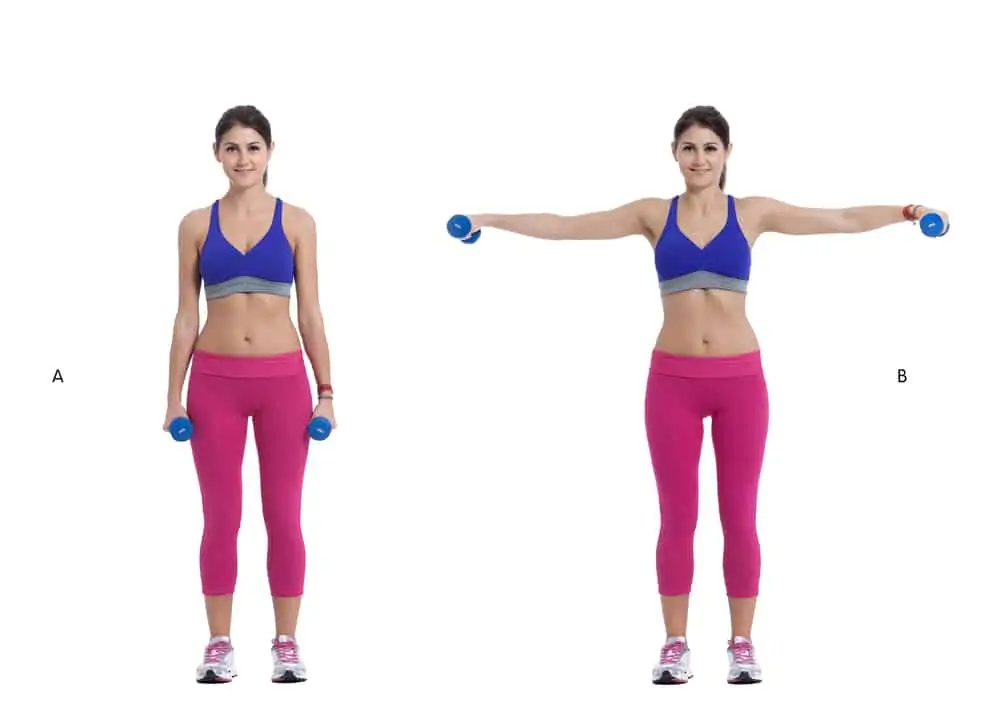
Common mistakes during a lateral raise
- Using a weight that’s too heavy
- Rotating the palms down, placing the shoulder in internal rotation, and further compressing the supraspinatus
- Raising the elbows too high (above shoulder level), compressing the supraspinatus
- Hiking the shoulders up and substituting with the upper traps
- Swinging and using momentum
Substitution ideas include flexion in the scapular plane below shoulder height to improve supraspinatus strength or modified range abduction with reduced weight.
2. Upright rows
The upright row is an exercise used to target shoulder and upper back strength.
People seem to love upright rows.
Even when I take Les Mills Body Pump, the upright row appears in Every. Single. Release. (And they’re in the hundreds now.)
P.S. – If anyone from Les Mills is reading, I’d love to chat about injury prevention, so hit me up.
(For a detailed list of modifications for shoulder pain during Les Mills Body Pump, see this article.)
Now before I said, there aren’t really any bad exercises (just appropriate or inappropriate depending on the person), but the upright row is an exception and kind of a bad exercise from the get-go.
Let me explain.
The upright row sets you up for pain from the start because the movement already places the shoulder in internal rotation, decreasing the space for the supraspinatus tendon.
If using a barbell, the shoulders are even more restricted to a somewhat dictated path of motion.
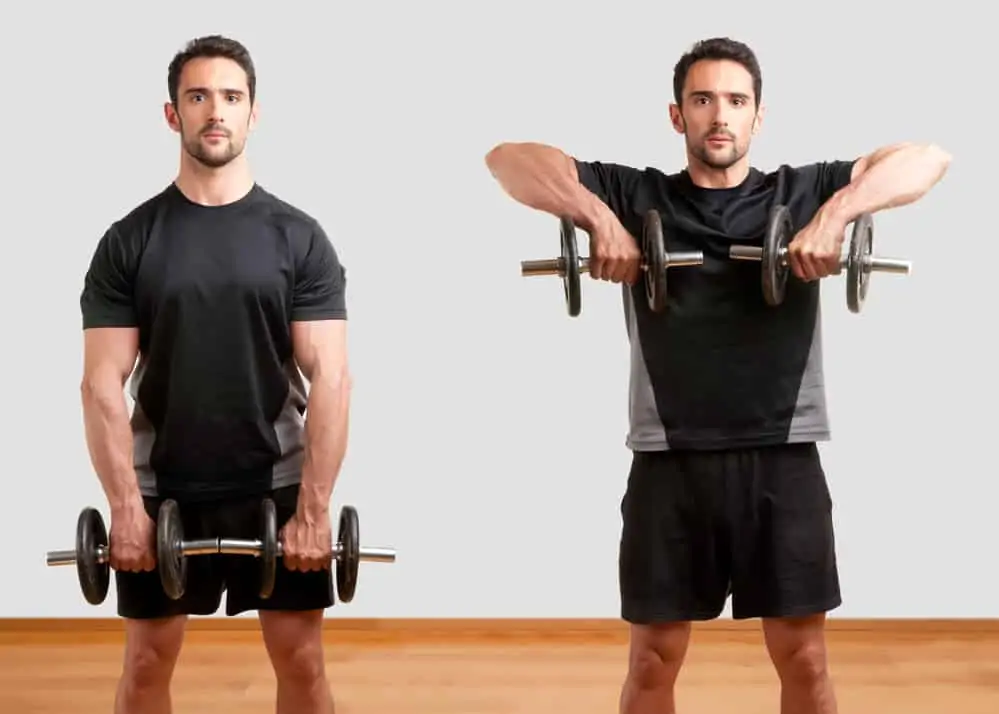
As you lift the weight, the rotator cuff tendon can get pinched in between the head of the humerus and the acromion of the scapula (especially if you’re rounding your upper back).
It’s that combo of internal rotation and elevation of the arm that makes this so rough on the shoulder. The higher you lift, the worse it gets.
If you insist on doing upright rows (or are captive in a Body Pump class), at least limit your range of motion or switch to free weights so you can adjust the angle and decrease some of the internal rotation on the shoulder.
I really like how Jeff Cavaliere explains this in the video below. He’s a PT and a strength coach. And he demonstrates with a skeleton. Who doesn’t love a good skeleton demo?
Even at its best, the upright row isn’t great. If you’re a die-hard upright row fan, keep these tips in mind.
Common upright row mistakes
- Pulling too high
- Breaking at the wrist (more on this below)
- Using momentum
- Hiking the shoulders
- Rounding the upper back
Breaking at the wrist (allowing the wrist to flex during movements) is a common problem with many upper body exercises.
This compensation causes some of the force to be transferred away from the intended muscle group. As a result, the wrist extensors end up working more than they should.
Not only does this create poor overall movement patterns, but it’s a great way to develop tennis elbow.
Keep your wrists neutral as much as possible to avoid injury.
Pro tip: If you start noticing injuries piling up on the same side (such as shoulder and elbow pain), there’s something that the body is trying to compensate for.
It’s not just a coincidence.
Dysfunction keeps moving down the chain, overusing other areas.
3. Triceps dips
Triceps dips are one of the many ways to target the triceps and can be tricky if performed incorrectly.
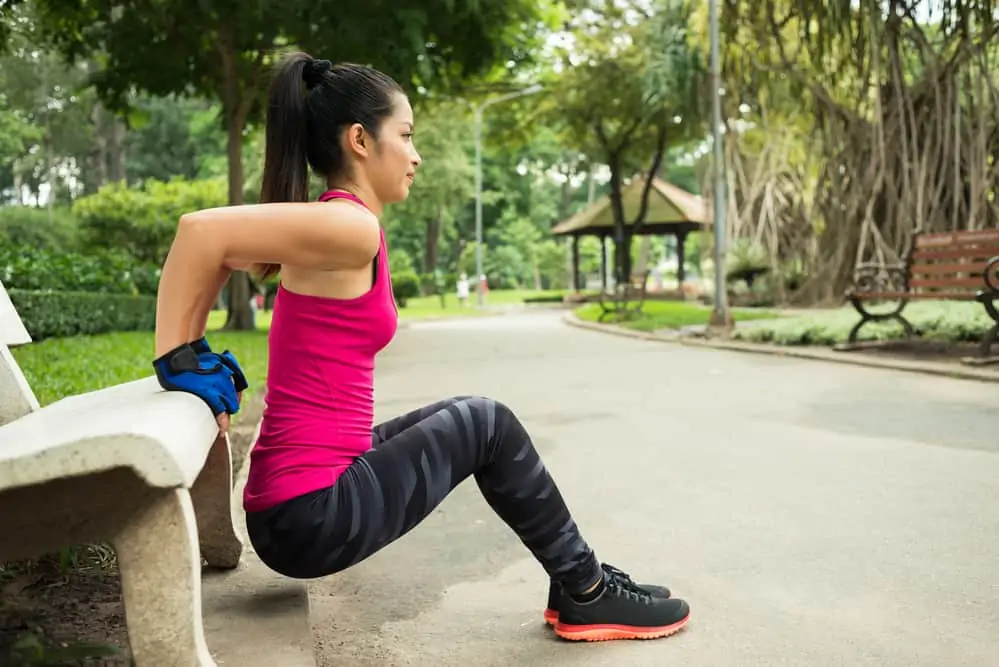
Common triceps dips mistakes include
- Keeping your bottom (center of gravity) too far away from your hands
- Rocking the body forward and back instead of actually bending the elbows
- Moving too low, placing additional stress on the front of the shoulder
- Rounding the shoulders and hunching the upper back rotates the scapula (shoulder blade) and decreases space in the shoulder joint
Many people do triceps dips on a bench with their fingertips pointing forward.
A lesser-known tip is to point the fingers slightly outward, giving some external rotation to the shoulder and thus providing a little more space for the rotator cuff.
Substitute with triceps pulldown at a cable machine or kickbacks to work the triceps but place less stress on your injured shoulder until you’re ready to progress.
4. Lat pulldowns behind the head
To be fair, you shouldn’t be doing this with healthy shoulders either.
Lat pulldowns behind the head were deemed a no-no quite a long time ago, but I guarantee if you spend a few hours in a gym, you’ll still see people who didn’t get the memo.
Some who only subscribe to “Bro science” in the weight room might still argue that pulling behind the head is better for muscle activation.
The behind-the-head lat pulldown increases the chances of developing anterior shoulder instability. Anterior instability is associated with other soft tissue injuries (rotator cuff injuries) or other ligament or cartilage damage over time.
If you don’t have enough shoulder range of motion (ROM), this might cause you to awkwardly pitch your head forward and substitute with other muscles, creating more issues.
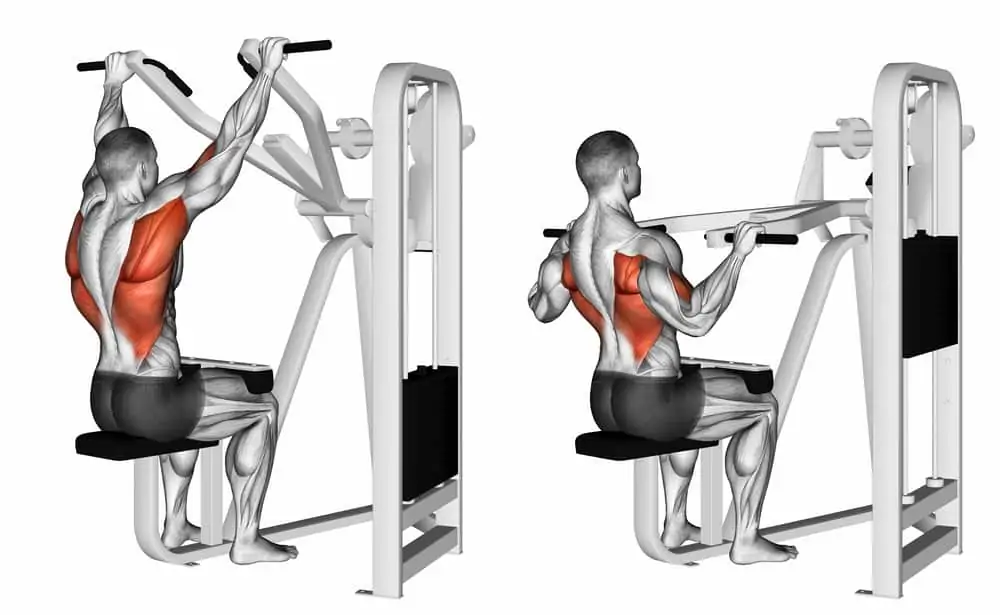
Switching to a front pull-down reduces wear and tear on the shoulder and provides a more functional movement (which will benefit you in real life.)
EMG studies show that the same or greater lat muscle activation occurs when you pull the bar in front of you. Lusk SJ et al. found that a pronated grip (palms facing away from you) had the most lat muscle activation.
You can also try different grip positions to see what feels best for your shoulder. A neutral grip might feel the best if you’re nursing a shoulder injury.
Other common lat pulldown mistakes include
- Leaning back too far
- Rounding the upper back
- Pulling the bar behind the head or too low
- Using momentum
- Hiking the shoulders
5. Lap swimming
Many turn to swimming rather than weights because they think the pool will somehow be more kind to their shoulders.
I’m sorry to say that rotator cuff injuries are one of the most common swimming injuries.
The risk also increases for novice swimmers without refined stroke mechanics or seasoned swimmers who are overtraining.
If you’ve never had any formal stroke training, the chances are that swimming may do more harm than good as it’s still a resistance exercise with plenty of repetitive overhead movement.

Freestyle and backstroke are likely to aggravate an injured rotator cuff due to repetitive overhead motion. (As does butterfly, but most casual swimmers never go near this stroke, so it goes without saying that it’s rough on the shoulders.)
Breaststroke may be ok, but it depends on the quality of your stroke and the severity of your pain. There is still an overhead reaching component, but it doesn’t follow the same arc as freestyle and backstroke.
Also, caution with kickboards.
They sound easy on the shoulders since you’re just kicking, but don’t hold the kickboard out in front of you; otherwise, it will stress the injured rotator cuff. Instead, try holding the kickboard at your chest to give your shoulders a break.
If swimming is part of your routine, beware of overtraining, not varying your strokes, or using pull buoys or paddles for too long.
The same precautions apply to water aerobics. Unfortunately, you’re not free from injury possibility just because you’re in a pool.
Here are some more tips to avoid injury while lap swimming.
6. Overhead movements with weights
Painful overhead reaching is a common complaint with rotator cuff injuries.
Overhead movements, especially with weight reaching behind the neck, are likely to aggravate a cranky rotator cuff.
Examples are overhead press or triceps press, especially anything where the center of gravity goes behind the neck.
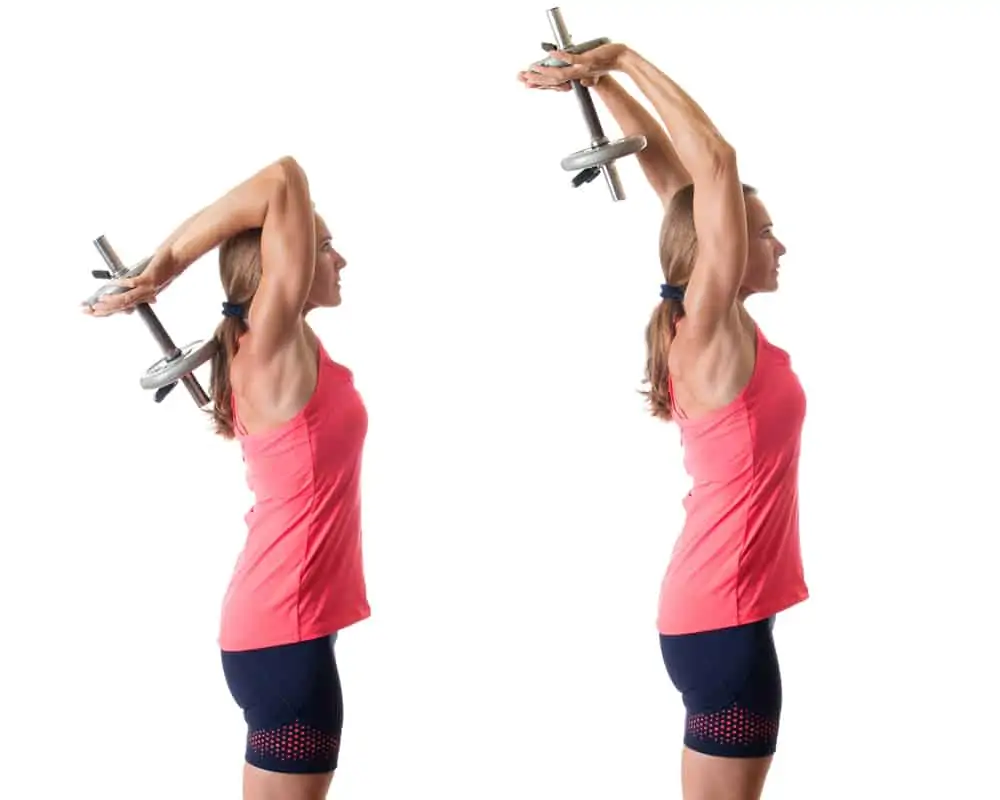
Now you can’t really train overhead strength without reaching overhead, so there isn’t quite an exact substitute. But, you may be able to train shoulder flexion in a range below the shoulder that does not aggravate your symptoms until you can safely progress back.
7. Overhead throwing or serving sports
Whether you’re an athlete or just like to throw the football around at half-time, sports involving throwing or serving can aggravate cranky shoulders.
So if you already have a painful shoulder, it’s probably not going to “loosen up” after a few throws.
It may be best to take a break or work on other fundamentals of your sport until your shoulder feels better.

8. Yoga poses to modify or avoid with a rotator cuff injury
Yoga is often seen as a gentle exercise. While sometimes this is true, it depends on the yoga style and the poses you’re doing.
Yoga isn’t free from injury.
Here are some ideas to modify your practice when dealing with a rotator cuff injury. Your tolerance to these will depend on what type of injury.
You can also check out my Hands-Free Yoga Practice on YouTube here.
Weight-bearing through the arms
Poses such as downward facing dog, plank, side plank, or other arm balances can be tough on the shoulders.
For downward facing dog, be sure to keep the shoulders away from the ears. Also, turn the front of the elbows toward the top of the mat. This slight adjustment externally rotates the shoulder and gives more space for the supraspinatus tendon.
Overhead movements
Sometimes just raising your arms overhead is enough to anger a cranky rotator cuff.
Choose different arm variations in Warrior poses or any other pose with an overhead reach component.
Binds
Binds involve wrapping the arms around the back or legs and require a fair amount of shoulder internal rotation motion to be performed correctly.
Internal rotation tends to be a tough movement for a rotator cuff injury.
Use blocks and straps to shorten the distance and take some demand off of your shoulders.
It might also be wise to skip binds for a while.
Bonus: anything that increases your pain
Almost any upper body or core exercise can increase rotator cuff pain if performed improperly.
Modify range of motion and weights to ensure no pain while working around an injured rotator cuff.
Always check in with your form and ensure you can perform exercises without substituting with momentum or other muscle groups.
Performing exercises with good form and without pain are more important than how much weight you can lift.
What other exercises are bad for the rotator cuff?
To be fair, almost any upper body exercise can be harmful if performed incorrectly. Proper form is essential in keeping the rotator cuff healthy.
I’d also like to preface this section by saying I’m not a fan of labeling exercises as “good” or “bad.”
Whether an exercise is appropriate (or not) for you depends on many factors such as your fitness level, current injuries, medical conditions, goals, job, or sport-specific requirements.
Blindly labeling exercises as good or bad is a disservice and means nothing without context.
Also, the rotator cuff is not just one muscle.
It’s a group of four muscles, but the supraspinatus is the most frequently injured because of its location and actions. Therefore, this is typically what people are referring to when they say “rotator cuff injury.”
If you want to read more about the shoulder mechanics and why this area tends to be so vulnerable, check out How To Avoid Shoulder Pain While Working Out.
If you’re looking to improve your upper body muscle anatomy, read The Complete Guide To Upper Body Muscles For Exercise.
Can you workout with a torn rotator cuff?
Not everyone wants or even needs to have surgery for a torn rotator cuff, especially with smaller-sized tears.
The short answer is yes, it’s completely possible to workout safely with a torn rotator cuff. Strengthening has been shown to improve tendon integrity and restore normal movement patterns to optimize function.
The longer answer is it depends and there may always be some ranges of motion or exercises that feel painful, awkward, or are unavailable to you.
If you’re unsure if you should be working out with a torn rotator cuff or what exercises are beneficial for you, speak with your physical therapist.
Activities to avoid with a rotator cuff injury
Everyone always wants to know how they can get better faster.
The secret is, it’s not just what you’re doing (or not doing) at the gym. Regular everyday tasks can perpetuate rotator cuff pain too.
Give your injured arm a chance to heal by modifying or skipping non-essential tasks. Your bathroom will still be there to clean when your shoulder heals.
It’s important not to push through the pain with things like:
- Overhead reaching
- Chores or yard work
- Reaching behind your back
- Reaching out to the side
- Lifting and carrying
- Sleeping on the affected shoulder
Wrapping up
Strengthening exercises are an essential component of a healthy fitness routine.
Shoulder movement is complex. Good form and movement awareness are essential for preventing and healing rotator cuff issues. Modifying movements and moving smartly will help your shoulder heal faster.
Ignoring shoulder pain can lead to a frozen shoulder or even a torn rotator cuff. If you suspect a rotator cuff problem, get physical therapy early to avoid chronic pain.
Read How To Ease Shoulder Impingement Pain for some expert insight and tips to get better faster.
References
Andersen V, Fimland MS, Wiik E, Skoglund A, Saeterbakken AH. Effects of grip width on muscle strength and activation in the lat pull-down. J Strength Cond Res. 2014 Apr;28(4):1135-42. doi: 10.1097/JSC.0000000000000232. PMID: 24662157.
Lusk SJ, Hale BD, Russell DM. Grip width and forearm orientation effects on muscle activity during the lat pull-down. J Strength Cond Res. 2010 Jul;24(7):1895-900. doi: 10.1519/JSC.0b013e3181ddb0ab. PMID: 20543740.
Snarr, Ronald & Eckert, Ryan & Abbott, Patricia. (2015). A Comparative Analysis and Technique of the Lat Pull-down. Strength and Conditioning Journal. 37. 21-25. 10.1519/SSC.0000000000000173.
Tovin BJ. Prevention and Treatment of Swimmer’s Shoulder. N Am J Sports Phys Ther. 2006;1(4):166-175.


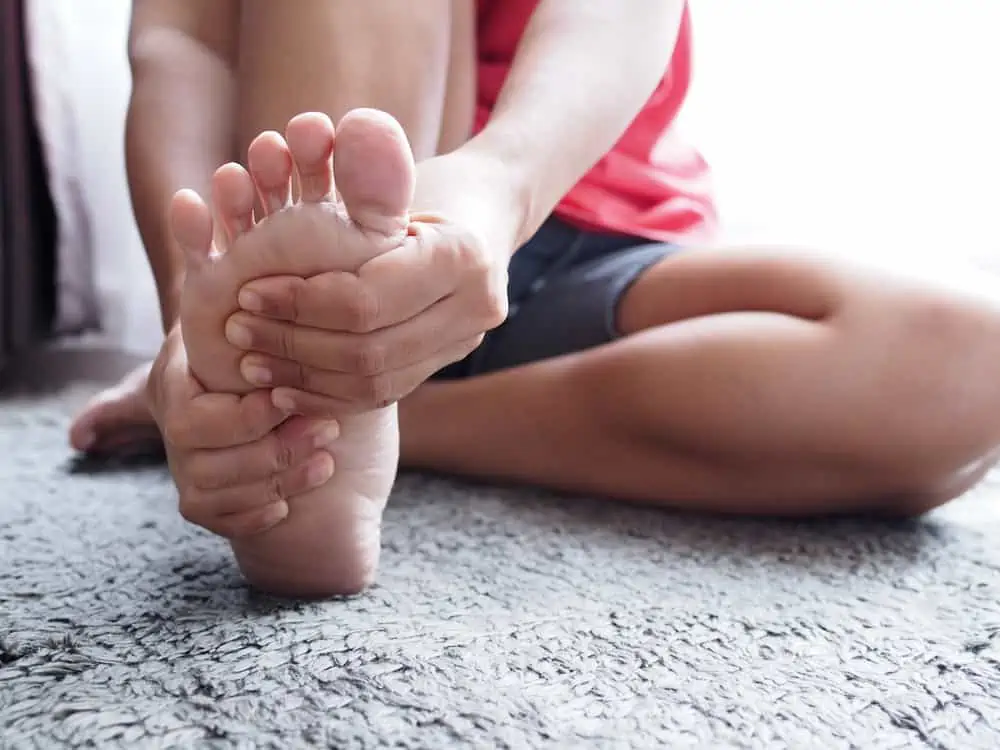
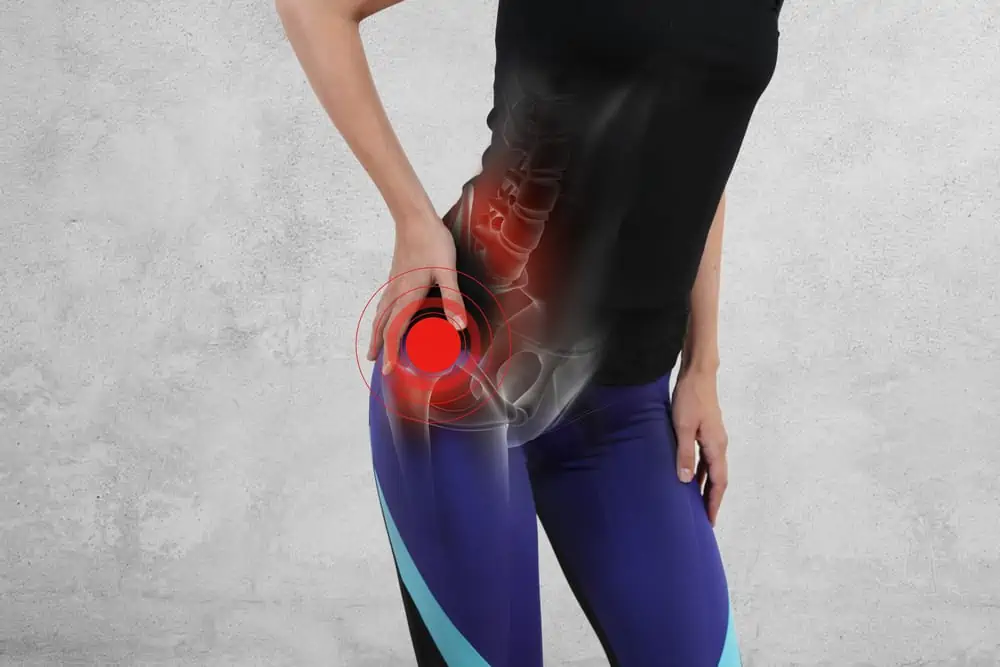
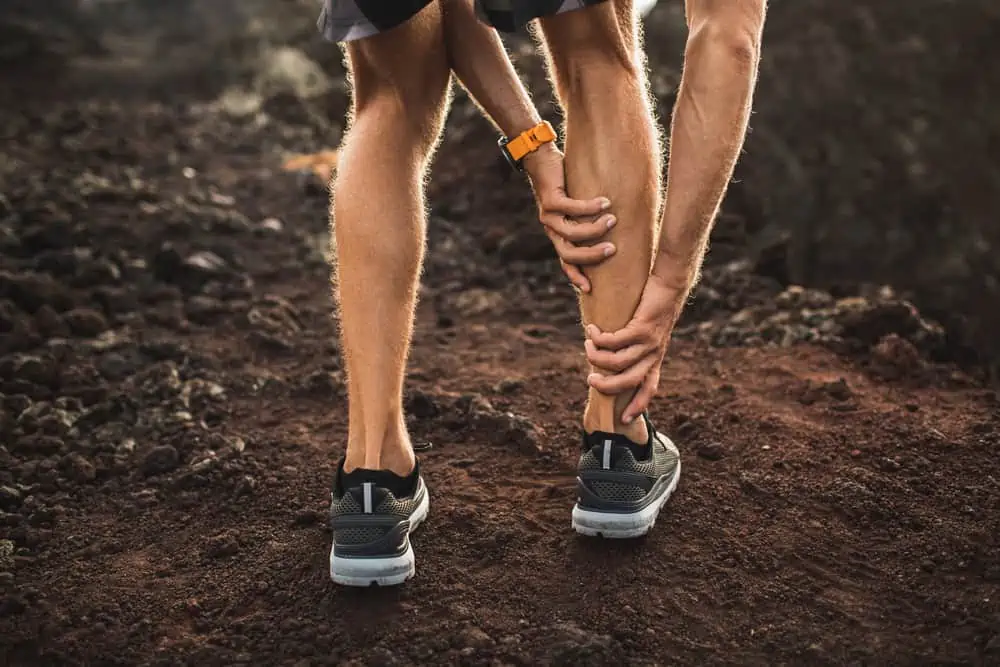

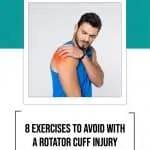

Excellent post with great details. Thank you for sharing these great tips. Dealing with injuries while recovering and exercise can be difficult but possible as you write about. Physical therapy helps and they teach you great things to include to help in your healing. Thank you for sharing this important post.
Thank you so much for reading and taking the time to comment. I’m glad it was helpful.